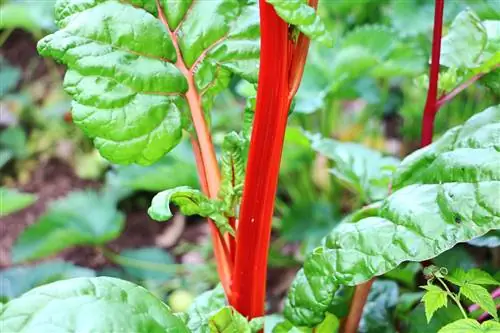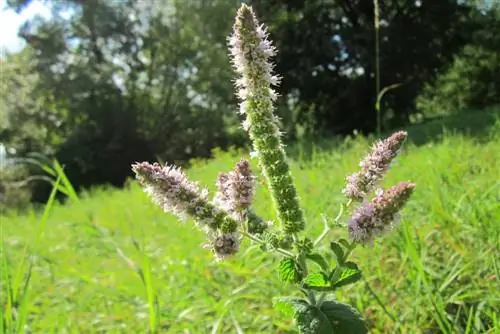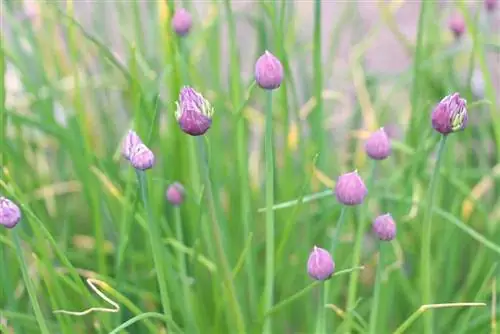- Author admin [email protected].
- Public 2023-12-17 03:39.
- Last modified 2025-01-24 12:45.
The question always arises as to whether the flowering rhubarb is edible and can be harvested safely. Find out here why rhubarb season is directly related to flowering and whether flowering rhubarb is suitable for consumption!
Flowering time
The rhubarb season generally ends on June 24th, as the so-called St. John's shoot begins at this time. This is the second growth spurt, because the rhubarb is now gathering strength for the winter and the following year. To support this process, the plants are harvested shortly beforehand. Furthermore, the plants now form their first flowers if they have previously been exposed to a cold stimulus. As a rule, flowering begins when the rhubarb is exposed to a temperature of a maximum of 10 degrees for a period of 12 to 16 weeks. Once the so-called vernalization has taken place, the rhubarb forms a panicle inflorescence from June onwards. This can grow up to 40 cm high and contain up to 500 cream-colored flowers.
Properties of rhubarb flowers
Rhubarb forms its flowers to attract insects and thus start its reproduction. The rhubarb flowers are therefore considered extremely useful for numerous insects, because the easily accessible pollen and the tasty nectar attract natural helpers such as bees and bumblebees. But it's not just wildlife that enjoys the inflorescences, as we humans can also use them in a variety of ways. On the one hand, the cream-colored flowers are ideal as decoration in the house and on the other hand, they can be used to make tasty dishes. Contrary to popular belief, flowering rhubarb is safe to eat.
Rhubarb contains oxalic acid
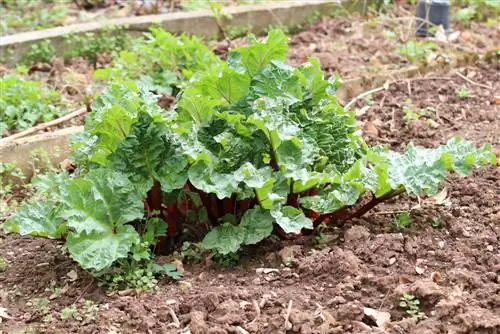
Many hobby gardeners mistakenly believe that rhubarb becomes poisonous once it flowers. This misconception is often justified by the increasing content of oxalic acid. This is built up during the vegetation phase and is therefore lowest in May and April and highest from June onwards. Although the oxsalic acid content is highest during flowering, the concentrations are generally harmless to he alth. However, some parts of the plant, such as the leaves and the bark of the stems, contain a particularly high amount of oxalic acid. It is therefore advisable not to consume these parts of the plant, but to remove them directly when harvesting.
Oxalic acid is toxic
Oxalic acid is an odorless and tasteless substance whose consumption can lead to undesirable side effects. Oxalic acid binds calcium in the organism and at the same time prevents the absorption of iron. Oxalic acid also promotes rheumatism and kidney stones and is bad for joints. That's why people who suffer from gout, rheumatism or kidney stones in particular should only consume rhubarb in small quantities.
It is also known that the acid attacks tooth enamel. This is noticeable after eating the vegetables by a dull feeling in the teeth, which is often perceived as unpleasant. However, your teeth should not be brushed immediately after consumption, as “brushing” could cause additional damage to the already damaged tooth enamel. It is better to wait around 30 minutes after consumption. The tooth enamel has usually calmed down during this time and the unpleasant feeling has already disappeared.
Tip:
Rhubarb should never be eaten raw! Flowering rhubarb in particular should be cooked before consumption due to its increased oxalic acid content.
Poisoning by rhubarb hardly possible
According to scientists, the toxic effect of oxalic acid only occurs when around 5,000 milligrams of oxalic acid are consumed. Since 100 grams of rhubarb contains around 150 to 500 milligrams of oxalic acid, poisoning is almost impossible. An adult with a body weight of around 60 kilograms would have to eat 36 kilograms of rhubarb to cause a toxic effect. The same applies to children: a child with a body weight of around 20 kilograms would therefore have to consume around 12 kilograms of rhubarb.
Harvest
Rhubarb is usually harvested from the beginning of April and by June 24th at the latest. If the vegetables are harvested at a later date, this usually affects the taste, which is often described as “woody”. It is therefore advisable to harvest rhubarb as early as possible. You can tell whether the plants are ripe by their appearance, because plants that are ready to harvest grow upright and have no wavy leaves. In addition, the tissue between the ribs on the rhubarb stalks is smoothed. Another characteristic of ripeness is the color of the rhubarb stalks, which ranges from a rich red to a fresh green. As soon as the rhubarb has these characteristics, the starting signal for the harvest is given.
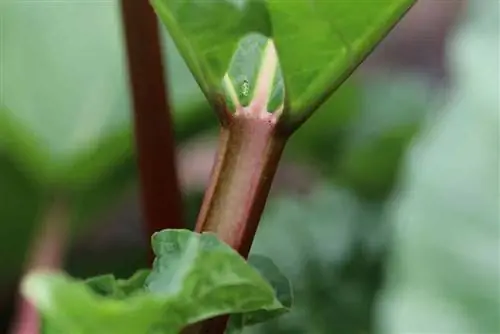
To harvest the rhubarb, grasp the plant stem at the base and twist it out clockwise. Under no circumstances should the plant be cut off with a knife, as the resulting cut significantly increases the risk of rot. The leaves and the whitish stalk in the lower part of the rhubarb stalk are then removed. Harvesting the flowers is the same way: the flowers are grasped at the base of the stem with your fingers and at the same time twisted out clockwise.
Tip:
In order for new rhubarb stalks to grow, all stalks should never be harvested. It is better to always leave around two thirds of the stalks standing and only harvest young plants from the second year onwards.
Storage
The top priority for storing rhubarb is: Never store it in aluminum foil or in aluminum containers! The oxalic acid contained in the plant reacts with the aluminum and dissolves it. It is better to wrap the freshly harvested rhubarb in a damp cloth and then store it in the refrigerator. However, rhubarb only has a shelf life of a few days, which is why it is best processed or preserved straight away. Freezing is particularly suitable for preserving vegetables for longer. The best way to do this is to peel the rhubarb and cut it into small pieces. The rhubarb can then be stored in a plastic bag or a plastic container in the freezer.
Conclusion
Some parts of the rhubarb plant are considered poisonous, but they are not suitable for consumption anyway. However, the stems and flowers can be safely harvested after June 24th and then further processed or preserved.


